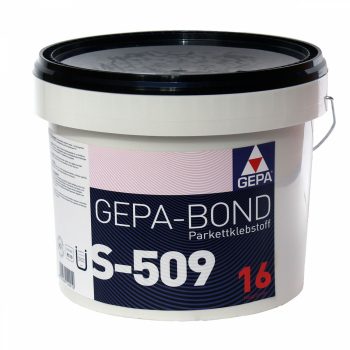
GEPA-BOND S-509 – flexible silane based adhesive
High-quality, single-component, water and solvent-free adhesive based on MSP technology. Only indoors for gluing of strip parquet according to DIN EN 13226, edgewise according to DIN EN 14761, mosaic parquet according to DIN EN 13488 and solid boards. Also for 2- and 3-layer multi-layer parquet and for approved laminate floors.
Consumption
Approx. 0.8 – 1.2 kg/m³ depending on substrate, parquet type and toothing.
Recommended tools
Notched trowel B3, B11, B13.
Working time
Approx. 30 – 45 min.
Final strength
After approx. 48 hrs.
Packaging
16 kg – EUR 87,12 (EUR/kg 5,445)
Price including VAT.
* The terms of the contract and the right of withdrawal can be found in the Documents section.
* This product is one of the regulations of the Cabinet of Ministers No. 255, 22nd article exceptions, where the customer cannot exercise the right of withdrawal.
€87,12
Description
Documents
High-quality, 1- omponent, water and solvent-free adhesive based on MSP technology. Only indoors for gluing of strip parquet according to DIN EN 13226, edgewise according to DIN EN 14761, mosaic parquet according to DIN EN 13488 and solid boards. Also for 2- and 3-layer multilayer parquet (including individual rods) and for approved laminate floors. Suitable for underfloor heating systems.
Storage: can be stored frost-free, cool and dry on wooden shelves in the unopened original container for: 365 days.
Store in a dry, well-ventilated place at a temperature between 15 ° C and 25 ° C. Protect from heat and direct sunlight. Keep tightly closed.
Recommended tools: notched trowel B3, B5, PK/B11, B15, B17.
Processing: the adhesive must be applied to the whole surface of the substrate with a suitable notched trowel. Working time is approx. 30 – 45 minutes. The parquet is to be laid in the adhesive bed with gentle sliding motions and pressed down firmly, so that the rear side of the parquet is fully covered with the adhesive. Walkable after approx. 24 hours. Hardening is delayed at low temperatures. At the earliest after 48 hours, the laid parquet floor can be sanded for the first time. The wood moisture must meet the relevant ÖNORM standards for adhesion. Observe the parquet manufacturers laying guidelines. The adhesive joint relieves shear forces and prevents the transmission of adverse forces to the substrate. Adhesive residues on parquet can be removed for a period of approx. 1 – 2 hours with light rubbing movements or R 500 cleaning cloths. Once set, the adhesive can only be removed mechanically.
Working time: approx. 30 – 45 min.
Final strength: after approx. 48 hrs.
Consumption: consumption depending on substrate, parquet type and toothing: approx. 0.8 – 1.2 kg/m3. Toothing B3, B5, PK/B11, B15: approx. 0.7 – 1.5 kg/m2. Toothing B17: approx. 1.8 kg/m2.
Processing temperature: ideally: +16 °C to +25 °C.
Suitable substrates: standard mineral substrates, cement screeds and concrete floor, calcium sulphate screeds, mastic asphalt, wooden substrates, dry screed, coated substrates. The substrate must be dry, free of frost, solid, load- earing, dimensionally stable and free of dust, dirt, oil, grease, solvents and loose parts and correspond to the applicable technical national and European guidelines, standards as well as meet the “generally accepted rules of the trade”.
Material advice:
– when working outside the ideal temperature and/or humidity range, the material properties may change significantly. Temper materials accordingly before processing!
– to retain the product properties, no foreign materials may be mixed in;
– water dosing amounts or thinning specifications must be precisely kept;
– check colored products before use for color accuracy;
– color consistency can only be guaranteed within a batch;
– the coloring is significantly influenced by the environmental conditions;
– the adhesive contents may cause damaging interactions with the surface treatment materials.
Environmental advice:
– DO not process at substrate temperatures under +15°C;
– the ideal temperature range for material, substrate and air is +15 °C to +25 °C;
– the ideal relative air humidity range is between 40% to 60%;
– increased humidity and/or lower temperatures delay, lower air humidity and/or higher temperatures accelerate drying, setting and hardening. Ensure adequate ventilation during the drying, reaction and hardening phase; avoid draughts;
– protect against direct sunlight, wind and weather;
– protect adjacent components!
Tips:
– we recommend using a test surface first or a small area for initial, small-scale testing. – Observe the product data sheets of all MUREXIN products used in the system.
– keep a genuine original container of the respective batch for later repair work.
